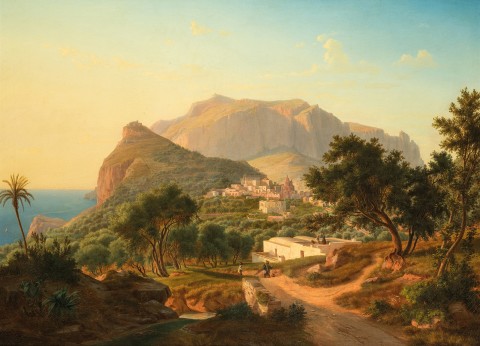ABENDLANDSCHAFT VON DER INSEL CAPRI, 1846 (EVENING LANDSCAPE FROM THE ISLAND OF CAPRI)
EUGENE VON GUÉRARD
oil on canvas
75.0 x 103.5 cm
signed and dated lower right: Eug. V. Guerard / Df 1846
Emil Vorster, Broich, Germany, 1846
Private collection, Dusseldorf, Germany
Christie’s, Melbourne, 22 August 2000, lot 100 (as ‘Capri’)
Private collection, Sydney
Annual Exhibition of the Art Association of Rhineland-Westphalen, Düsseldorf, 1846 (as ‘Abendlandschaft von der Insel Capri’)
Capri, pencil on paper, 30.5 x 46.8 cm, inscribed with date and title lower left: Capri d. 2ten Mai 38, Private collection, United Kingdom
The enchanted island of Capri in Italy’s Bay of Naples is as renowned for its beauty as its history. Rugged rocks and the fabled Blue Grotto compete with tales of the pleasure villas of the Roman emperors Augustus and Tiberius. It became a magnet for artists, writers, grand tourists and, more recently, the rich and famous. All its magic is captured in Eugene von Guérard’s Abendlandschaft Von Der Insel Capri, 1846, through the singularity of his vision – striking realism, geological fascination, mood and narrative intertwined. Imbued with nineteenth-century German Romanticism, its brilliant technique is in service to the sublime in nature. The painting’s story begins when the Vienna-born Eugene travelled to Italy with his father, Bernard. Settling in Naples in 1832, Bernard secured portrait commissions at the Bourbon court of Ferdinand II, King of the Two Sicilies, and in the summer months father and son explored the spectacular region on expeditions recorded in Bernard’s one, and Eugene’s three, surviving Neapolitan sketchbooks.
Von Guérard made his first visit to the island in the summer of 1835 when its popularity as a destination for landscape painters was at its peak. Among the nineteenth-century German artists to visit, many inspired by Goethe’s close friend, the Neapolitan court painter, Jakob Phillip Hackert, were August Kopisch, who famously rediscovered the Blue Grotto in 1826, Ernst Fries, Leo von Klenze, Johann Christian Dahl, Franz Catel, Carl Morgenstern – and von Guérard. The drawing for the present work was inspired by his second, and ‘farewell’, visit to the island, in early May 1838;1 by the 21st of that month he was on his way to Düsseldorf, the home of one of the most dynamic art academies in Europe.
Von Guérard’s precise and exquisitely detailed pencil drawing – and his remarkable memory for light and colour – armed him with all the information required to realize his vision on canvas eight years later. Following the dusty road down into the saddle in the middle of the island the township of Capri comes into sight – the dome of the seventeenth-century church of San Stefano clearly identifiable. Mount Solaro and the spectacular limestone cliffs, behind which the settlement of Anacapri sits, soar above the town. The complex topography of the island, the irregular contour of Mount Solaro, and the subtle planar shifts in the sheer walls of limestone, recorded with such assurance in pencil on paper by the younger artist, are, in the painting, suffused in Mediterranean light and colour. The palette, an orchestration of the terracotta pinks of the earth and architecture, the grey-greens of olive groves and the saturated blues of sea and sky, was so deeply impressed on his memory that it readily came to life in his Düsseldorf atelier. In this dynamic composition, myrtle trees bend and arch to frame the vista of the township; they seem to welcome the villagers making their way homewards in the warmth of the late afternoon sun. Far below, the languid movement of a single sailboat is traced in the intensely blue waters of the Tyrrhenian Sea. And, as in the best of von Guérard paintings, closely observed details sit in perfect equipoise with an expansive breadth of vision.
The real hero of this work is light and its transformative power: villas and casas glow as sun’s low rays strike their faces, and solid limestone cliffs, dissolved in Mediterranean light and atmosphere, take on an ethereal and dreamlike quality. The entire canvas is luminous.
In 1882, en route from Melbourne to Düsseldorf, von Guérard made one last visit to Capri, this time to share its beauty with his wife Louise and their daughter Victoria.
1. Eugene von Guérard, Capri, pencil, 30.5 x 46.8 cm, inscribed lower right: Capri d. 2ten Mai 38, Private collection, Coates, United Kingdom.
RUTH PULLIN AND DAVID THOMAS
